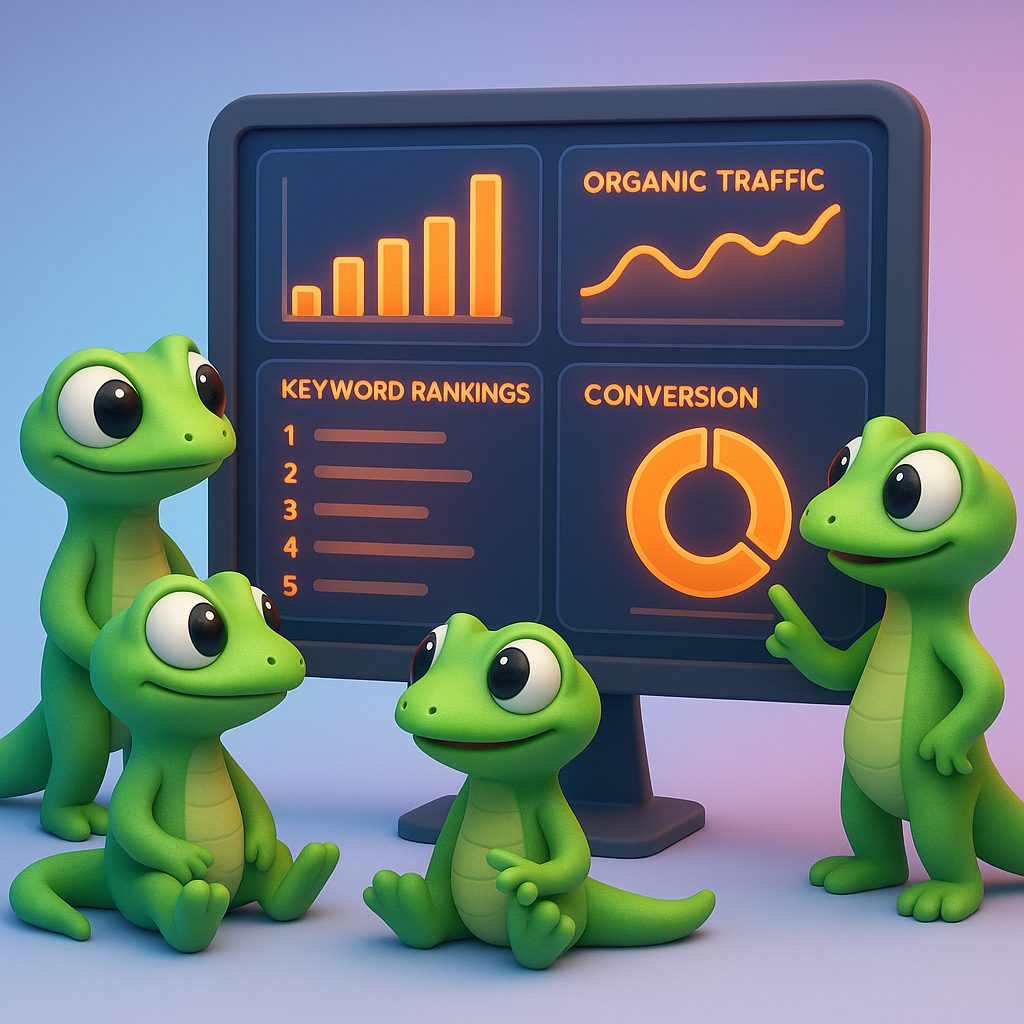SEO Dashboards for Efficient Organic Traffic Tracking
A comprehensive SEO dashboard serves as your mission control center for monitoring, analyzing, and optimizing organic search performance. For marketing leaders and SEO professionals looking to streamline reporting processes while maximizing visibility, ContentGecko’s dashboard solutions deliver real-time insights with customizable views tailored to your specific business objectives.

What is an SEO Dashboard?
An SEO dashboard is a centralized visual interface that aggregates real-time data from multiple sources to highlight performance trends, flag potential issues, and reveal organic growth opportunities. Unlike scattered spreadsheets or disconnected tools, a proper dashboard provides a unified view of your SEO health across key metrics.
As one marketing director noted after implementing ContentGecko: “The ROI was undeniable after just one month—we reduced weekly strategy meetings from 2 hours to 30 minutes by having all our data in one place.” This efficiency gain is representative of the 86% of SEO professionals who now integrate AI tools into their workflows, though ContentGecko users consistently report results that exceed the industry average.
Essential SEO Dashboard Components
A well-constructed SEO dashboard should include these critical elements:
1. Organic Traffic & Conversion Metrics
- Traffic volume trends (daily, weekly, monthly)
- Conversion rates by landing page
- Revenue attribution to organic channels
- Year-over-year growth comparisons
2. Keyword Performance Tracking
Track your most valuable search terms with unlimited keyword rank tracking capabilities that show:
- Position changes over time
- SERP feature visibility (featured snippets, knowledge panels)
- Competitor ranking comparisons
- Keyword clustering by topic
3. Technical SEO Health Indicators
Monitor site performance metrics that affect rankings:
- Core Web Vitals scores
- Mobile usability issues
- Crawl errors and indexation status
- Page load times for high-traffic pages
4. Content Performance Analysis
Measure how your content strategy drives results:
- Top-performing pages by traffic and engagement
- Content gaps versus competitors
- Internal linking opportunities
- Pages requiring updates or optimization
Customizing Dashboards for Different Stakeholders
ContentGecko’s dashboard solutions can be tailored to address the specific needs of various team members:
Executive Dashboard
For CMOs and directors focused on strategic outcomes:
- High-level traffic and conversion trends
- ROI measurements and business impact
- Competitive landscape snapshots
- Year-over-year growth visualizations
SEO Specialist Dashboard
For hands-on practitioners managing day-to-day optimization:
- Detailed keyword movement tracking
- Technical issue prioritization
- Content performance metrics
- Backlink acquisition and quality monitoring
Content Team Dashboard
For editors and content creators:
- Topic cluster performance
- Content gap opportunities
- CTR and engagement metrics
- AI-assisted content optimization recommendations
Building Your First SEO Dashboard
When creating a custom SEO analytics dashboard with ContentGecko, follow these steps:
- Define key objectives - Determine what success looks like for your SEO program
- Select relevant metrics - Choose KPIs that directly reflect your objectives
- Integrate data sources - Connect Google Analytics, Search Console, and other tools
- Create visual hierarchy - Organize metrics from highest to lowest priority
- Establish benchmarks - Set realistic targets based on historical performance
- Automate reporting - Schedule regular updates and stakeholder distributions
Turning Dashboard Data into Action
An effective dashboard isn’t just for monitoring—it should drive strategic decisions:
Content Refresh Strategy
Identify pages with declining traffic but strong keyword potential. One e-commerce client updated 15 declining product pages based on dashboard insights, achieving a 28% traffic increase within 60 days. This systematic approach to content refreshes has proven to be one of the most reliable ways to reclaim lost rankings and traffic.
Competitor Opportunity Detection
Use free keyword clustering tools to discover where competitors are losing rankings. A B2B software company captured 5,000+ new monthly visitors by targeting these gaps. Similarly, Viralsweep gained 2,172+ monthly clicks and top 10 rankings within a week using ContentGecko’s automation for competitor gap analysis.
Technical SEO Prioritization
Focus technical fixes on high-traffic pages with poor Core Web Vitals scores. This approach maximizes the impact of development resources on SEO performance. For example, one SaaS client improved Core Web Vitals for their top 10 traffic-driving pages, resulting in a 15% increase in page engagement metrics and improved conversion rates.
Reporting Tools and Integration Options
ContentGecko’s dashboard solutions integrate with popular analytics platforms:
Google Looker Studio
Create custom SEO dashboard templates in Data Studio for free visualization of:
- Search Console data
- Google Analytics metrics
- Custom calculated fields
- Multi-source blended data
Google Analytics Integration
Leverage Google Analytics for SEO reporting to connect user behavior with organic performance, showing:
- User journey analysis
- Conversion path attribution
- Audience segment performance
- Site speed impact on engagement
Comprehensive Audit Tools
Combine dashboard monitoring with regular website audit reports to identify:
- Structural issues affecting crawlability
- On-page optimization opportunities
- Site architecture improvements
- Technical debt impacting performance
Measuring SEO ROI Through Dashboards
Connect your SEO efforts directly to business outcomes using ContentGecko’s SEO ROI calculator alongside dashboard data to:

- Quantify traffic value by channel and page
- Forecast revenue impact from ranking improvements
- Justify resource allocation for optimization initiatives
- Compare efficiency across different SEO tactics
A particularly powerful application is calculating the projected value of specific ranking improvements. For instance, one e-commerce client used this approach to justify doubling their content optimization budget after demonstrating that a 3-position improvement for their top 50 keywords would yield an estimated $180,000 in additional annual revenue.
Best Practices for Dashboard Management
For maximum impact from your SEO dashboard:
- Start simple, then expand - Begin with core metrics before adding complexity
- Customize for each audience - Tailor views based on stakeholder needs
- Automate data collection - Minimize manual updates to ensure freshness
- Include competitive benchmarks - Add context through market comparisons
- Establish clear success metrics - Define what improvement looks like (e.g., 10% CTR increase)
- Schedule regular reviews - Set dedicated time to analyze dashboard insights
- Iterate continuously - Refine your dashboard as business objectives evolve
Many organizations fall into the trap of building overly complex dashboards that overwhelm users with data. As one ContentGecko client put it: “We went from 35 metrics that nobody looked at to 7 metrics that drive every decision.” This focus on actionable insights rather than data volume is critical for dashboard success.
Using AI-Powered Content Tools with Dashboards
Integrate dashboard insights with ContentGecko’s content writing tools to:
- Identify underperforming content needing updates
- Generate optimized content based on competitive gaps
- Scale content production for high-potential keywords
- Automate reporting of content performance metrics
The synergy between AI-powered content creation and data-driven insights creates a powerful feedback loop. For example, one SaaS company increased their blog output from 5-7 posts to 20+ monthly by using dashboard data to identify opportunities and AI tools to accelerate content creation.
TL;DR
Effective SEO dashboards transform complex data into actionable insights that drive organic traffic growth. ContentGecko’s customizable dashboard solutions help marketing leaders monitor performance, identify optimization opportunities, and demonstrate SEO value to stakeholders. By integrating real-time analytics with content optimization tools, you can create a complete ecosystem for managing and improving your organic search presence efficiently. Users consistently report exceeding industry averages for traffic growth, with case studies showing 45% organic traffic growth in 6 months through this integrated approach.
